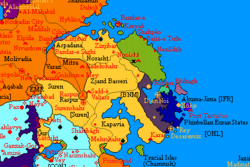Suren Confederation
- "Suren" redirects here. For the former independent state, which the Suren Confederation succeeded, see Suren Confederacy.
| Dowlat-e Aliyye-ye Suren | |||
| |||
| Motto: Marā dād farmūd-o khod dāvar ast | |||
| Anthem: Hymn of Eternal Eura | |||

| |||
| Map versions | |||
| Capital | Surenshahr | ||
| Largest city | Mehrshahr, Bandar-é Zinjibar | ||
| Official language(s) | Babkhi | ||
| Official religion(s) | Zurvanism | ||
| Demonym | Suren | ||
| - Adjective | Surenid | ||
| Government |
| ||
| - Surenšāh | Dāryuš Vištāspa | ||
| - Astabadh | Sardar Nur Mir | ||
| - Legislature | Majles-e Suren | ||
| Establishment | 1686 AN | ||
| Area | 2,412,144 km sq | ||
| Population | 25,612,063 (1738 AN) | ||
| Currency | Imperial Stater/Tomān | ||
| Calendar | Norton calendar | ||
| Time zone(s) | CMT +4 | ||
| Mains electricity | 230 V. 50 Hz | ||
| Driving side | Righthand-side | ||
| Track gauge |
| ||
| National website | |||
| National forum | |||
| National animal | |||
| National food | |||
| National drink | |||
| National tree | |||
| Abbreviation | SUR | ||
The Suren Confederation is a region of the Imperial State of Constancia.
History
Herein begins the history of the Suren Confederation, a region of the Imperial State of Constancia, from the centennial birthday of Basilinna Esmeralda al-Osman in 1741, the date of the official integration of the Suren Confederacy.
Geography
Government & politics
Since the successful integration of the Suren Confederacy, which took effect on the centennial birthday of Basilinna Esmeralda al-Osman in 1742, a Civil Administrator for the Suren Confederation, a national official appointed by the Basilinna and with voice and seat, but not vote in the Imperial Synkletos, possesses day-to-day executive authority, with significant staff support paid for by the Imperial Government.
Since 1731, it has been agreed and made legal convention, via Autokratorial Decree, that the Astabadh of the Suren holds this office in a concurrent capacity, similar to his counterpart in Raspur.
Executive
The Bab-e Dīvān (Gate of the Council), an antechamber to the entrance hall of the throne-room of the Surenshah from which a nest of eunuchs and the incense smogged droners of forgotten rites had been expelled, housed the reformed executive council which sat from 1.XV.1690 AN onwards and which took its name from the new location.
| Office | Office Holder | Portfolio |
|---|---|---|
| Astabadh | Sardar Nur Mir | Diplomacy, Public Administration |
| Euramehr Arteshbod | Ardashir Ghul | Defence and Security |
| Darik-Pat | The Bānū Aspadanadoḵt | Royal Estates, Revenues, Rites and Ceremonies, Bank of Suren |
| Timsar-e Ettelâ'ât va Amniyat-ē Kešvar | Ismail al-Osman | Espionage, Counter-Espionage, Industrial Archaeology and the Study of Foreign Technology |
| Moabadan-Moabad | Adur Ghilani | Religion and Law, Custodian of the Light of the Kapavs |
Legislature
Article 4 of the Third Amendment to the Magna Carta of 1667 provided that the 300-seat Majles-e Suren shall be deemed dissolved effective sunrise of the birthday on Basilinna Esmeralda in the year 1741.
The aforementioned Council retains some legislative authority, in the sense that it may recommend legislation to the Minister for Raspur.
The Majles-e Suren was reconstituted after the 1745 national Constancian election.
Administrative divisions
| Shahrestan | Shahrbān | Farmândâr | Sartip | Capital | Area | Population | Bakhsh |
|---|---|---|---|---|---|---|---|
| Shahbanu-uz-Spādānām | Ulugh Beg | Mihrab Khan | Arg-é Spahān | 976,604 | 9 | ||
| Kapavia | Sardar Akbar Mir | Yaqub Beg | Durmish Khan | Mehrshahr | 1,847,471 | 18 | |
| Norasht | Sardar Aʻzam Mir | Tughai Beg |
|
Bandar-é Zinjibar | 1,321,236 | 13 | |
| Suren Ostan | Sardar Nur Mir | Hamza Beg | Zahedi Khan | Surenshahr | 1,591,923 | 15 | |
| Trucial Isles (Chamrush) | Mirza Rustaham Sūrēn | Sohrab Beg | Bektash Khan | n/a | 356,850 | 3 | |
| Zjand Basseri | Sardar Káẓim Mir | Yulqoli Beg | Paykar Khan | Sadd-é Valiasr | 1,831,074 | 18 | |
| Ghur | Sardar Rustam Mir | Sohrab Beg | Rashan Khan | Ganzak-Gor | 3,056,331 |
Armed forces

Demographics
The Suren Confederacy experienced rapid population growth in the first three decades of the 18th century AN, driven by high fertility rates and industrialisation efforts initiated by the regime. The following table shows the estimated population figures for 1730 AN across the various shahrestans (provinces) that comprised the Confederacy at that time:
| Shahrestan | Population in 1720 AN | Estimated Population in 1730 AN | % Change (1720-1730) |
|---|---|---|---|
| Aspadana | 976,604 | 1,228,741 | +25.8% |
| Kapavia | 1,847,471 | 2,326,439 | +25.9% |
| Norasht | 1,321,236 | 1,664,610 | +26.0% |
| Suren Ostan | 1,591,923 | 2,004,841 | +25.8% |
| Trucial Isles (Chamrush) | 356,850 | 449,385 | +25.9% |
| Zjand Basseri | 1,831,074 | 2,306,243 | +25.9% |
| Ghur | 3,056,331 | 3,850,053 | +26.0% |
| Total | 15,938,821 | 20,072,980 | +25.9% |
From a total of around 15.9 million subjects in 1720 AN, the Confederacy's population surged to an estimated 20.1 million by 1730 AN, an increase of nearly 26% over just one decade. This sharp rise can be attributed to:
- High birth rates prevalent across Eura, especially in rural areas
- Campaigns to boost population growth as part of the regime's industrialisation agenda
- Resettlement of war refugees and veterans in conquered territories?
The most populous shahrestan was Ghur with 3.85 million residents, followed by the longstanding Surenid heartlands of Kapavia and Zjand Basseri. Even smaller provinces witnessed substantial demographic expansion in this period.
However, the uncontrolled population boom also brought new challenges. Food insecurity, infrastructure constraints, and dwindling resources increasingly strained the Confederacy's fragile economic revival in the aftermath of multiple conflicts. Environmental degradation from industrialisation and poor urban planning exacerbated living conditions for the burgeoning populace.
Without comprehensive reforms and sustainable development policies, the regime could potentially struggle to provide for the rapidly growing numbers that its pro-natalist stance had cultivated in its quest to rebuild the Neo-Babkhan state following years of war and turmoil.
Forecasting
An analysis of trends over the period 1729–1730 suggested that the Surenid population could potentially peak around the 1870s at approximately 45-50 million, before stabilising. This is contingent on the Confederacy following a transition trajectory similar to neighbouring states, albeit compressed into a shorter timeframe given its accelerated industrialisation efforts. However, a key caveat is that environmental degradation, resource constraints, political instability and other factors could significantly impact the optimistic projection for future Surenid growth.
Economy
In the wake of the 1730 Act of Restitution for the Tears of Anāhitā, the Suren Confederacy embarked on an ambitious programme to catalyze its own economic revival by capitalising on the unique properties of the newly discovered element Alexandrium. This strategy aimed to transform Suren from an impoverished, indebted, and war-torn nation into a dynamic industrial powerhouse on the continental stage.
Education
The Anjuman-i Ma'arf (Education Committee) was established under the 1697 National Education Act passed by the Majles-e Suren and promulgated through a Farman of Endorsement issued by the Imperial Court in the name of the Shahbanu.
Schooling for both genders is compulsory from the ages of seven to thirteen, with gender segregation beginning from the age of nine. The Education Committee was appointed to turn around the woeful literacy rates. Every satrapy must have a school per two thousand children, and be apportioned into catchment districts for this purpose. School masters must be paid for out of the public purse, and for this purpose a one-percent income tax is levied on every free adult subject of the confederacy. Teachers, male and female, may not enter the profession until they are forty-five years of age. No hint of public disgrace nor impropriety must attach to their name, and they must attend a tribunal of the mobads in order to have their Zurvanite orthodoxy and their literacy firmly examined. Teachers who are discovered and convicted of corrupting the children in their charge may be put to death by stoning or else, if there are mitigating circumstances, be sent out into the desert with one loaf of bread and one canteen bottle of water, charged never to return to the community on pain of summary execution.
Teaching is done by rote recitation of basic numeracy, Babkhi grammar, rhetoric, and literature, plus studies of Zurvanite texts which are learnt by convention, instruction, and rhetoric. At the age of thirteen the most promising ten percent of each school are retained to commence a technical education geared towards either agriculture or engineering depending upon the circumstances of the school's community. Those not selected for further education are put out to auction for apprenticeships.
Culture
The Suren remain socially conservative, as befits their Neo-Babkhan state, adhering to the stipulations of the Harmonious Society Act, as evidenced by the status of LGBT rights in the Suren Confederacy. The state religion of the Suren Confederacy is Zurvanism, although Mazdian, Yehudi, Nazarene, and Umraid minorities, may still be found in the country. The law prohibits the existence of atheists, Bassarid cultists, and daemon-worshipers. Such as are discovered are to be incarcerated for a period of forty days and forty nights, according them the opportunity to repent and ask for instruction in the Good Religion. Those who fail to do so by the end of the allotted span of days and nights are instead granted Zurvan's mercy.
Religion
Zurvanism derives from the earliest Euran religious philosophies of ancient Babkha. The message of Zurvanism, carried in scripture and the Gatha hymns, predate the teachings of the Nazarene and the Reciter by millennia. The faith taught by the Elder Zarathustra centred upon the primordial truth of the uncreated and eternal god Zurvan, the Highest Divinity and creator of all things, including Ahura Mazda and Ahriman, as well as the unceasing battle between the two opposing entities in which every facet and manifestation of creation must partake. The hierarchies of the Zurvanite priesthood, Mobads and Herbads, are embedded deeply into the fabric of the hardy communities to whose needs they minister, and their devotion to preserving both the purity of the souls of their congregations and the atash flames to which they tend means that the are ever vigilant for the first signs of corruption in man and beast. It is the Zurvanite clergy who bless the knives that end the lives of those poor wretches who succumb to the mutations occasioned by the radiological horrors which persist even to this very day, over a century after the atomic immolation of Old Babkha.
Ta'arof
The etiquette of Surenid, and indeed Euran, social interactions and relationships remain bound up in the old Babkhan fixation with hierarchy and status, expressed in the intricacies of the ta'arof - a word that essentially means the obligation of politeness. Offers of gifts and hospitality by a Surenid should be declined with polite apologies for three times in a row. If a Surenid persists in making a generous offer after the third refusal it may be treated as being sincere. Shopkeepers have been known to get themselves into trouble by 'refusing' payment only to find that a Constancian traveller has taken them at their word and sought to briskly depart the premises with the proffered goods firmly grasped in their hands.
List of Participants
- User:Continuator (founder)
- User:Edgard (contributor)
- User:Primo de aguilar (contributor)

